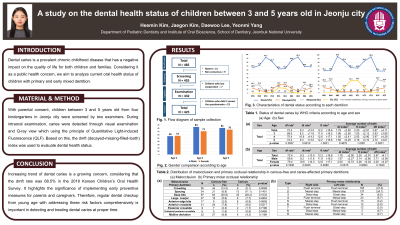Caries
325 - A study of dental health status of children between 3 and 5 year olds


Heemin Kim
student
Jeonbuk National universiy dental hospital
Department of Pediatric Dentistry, School of Dentistry, Jeonbuk National University, Korea
Jeonju, Cholla-bukto, Republic of Korea- YY
Yeonmi Yang, n/a
Professor
Jeonbuk National University Hospital, Korea
Jeonju, Cholla-bukto, Republic of Korea
Presenting Author(s)
Program Director(s)
Purpose: Dental caries is a prevalent chronic childhood disease that has a negative impact on the quality of life for both children and families. Considering it as a public health concern, we aim to analyze current oral health status of children with primary and early mixed dentition.
Methods: With parental consent, children between 3 and 5 years old from four kindergartens in Jeonju city were screened by two examiners. During intraoral examination, caries were detected through visual examination and Q-ray view which using the principle of Quantitative Light-induced Fluorescence (QLF). Based on this, the dmft (decayed-missing-filled-tooth) index was used to evaluate dental health status.
Results: Out of the total 451 participants, 47% were male and 53% were female. The age range of the participants was 3 to 5 years, with 27%, 36%, and 37% falling into each respective age group. The overall DMFT rate was 20%. The maxillary left central incisor had the highest DT rate, while the mandibular left first molar had the highest DMFT rate and FT rate. The most common molar key was flush terminal on both right and left side with deep bite being the most common malocclusion.
Conclusions: As the rate of dmft rate increases with age, it is important for parents and caregivers prioritize oral care early. Also, regular dental checkups from a young age are important in detecting and treating dental caries at an early stage.
Identify Supporting Agency and Grant Number:

.jpg)